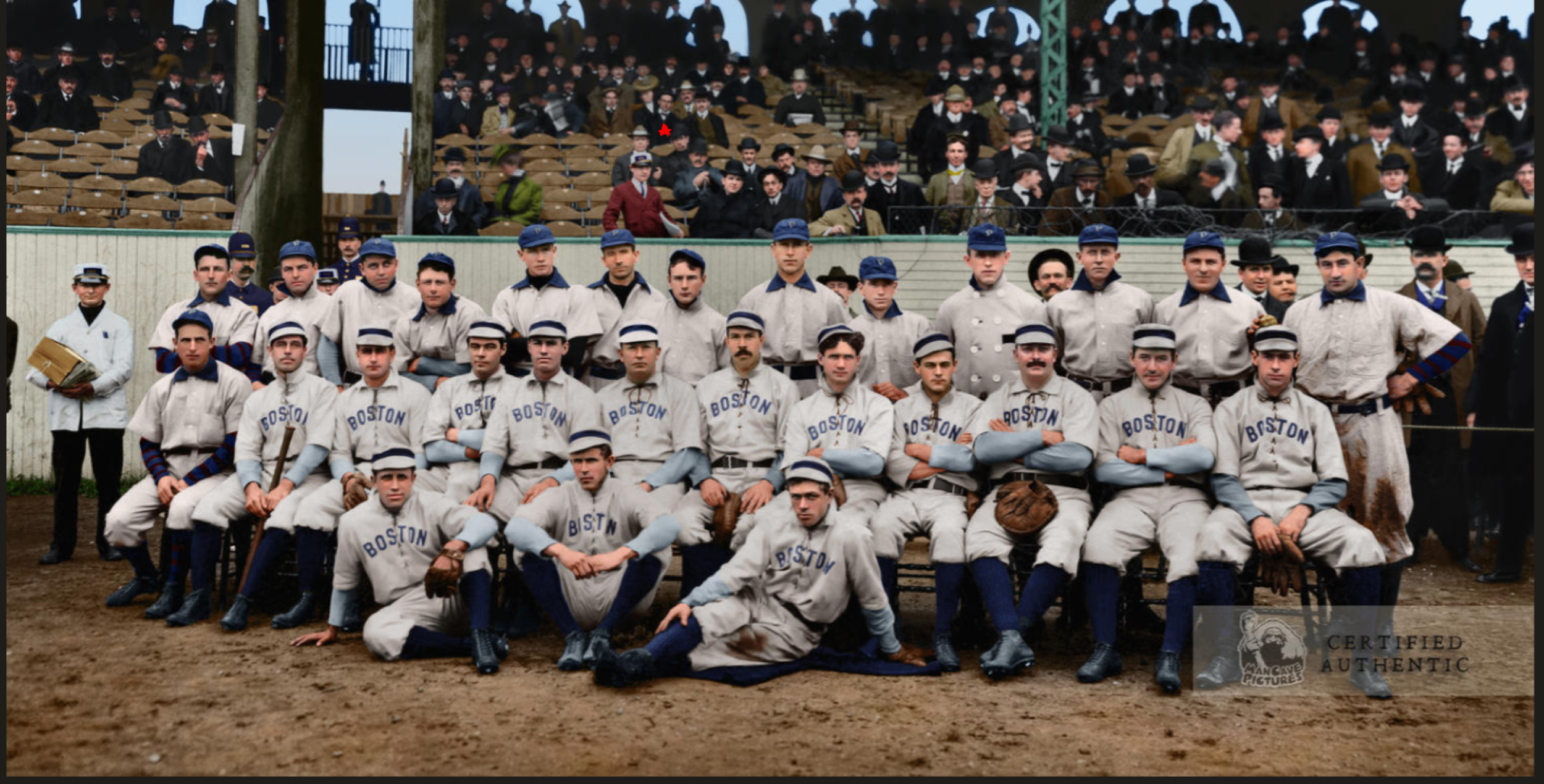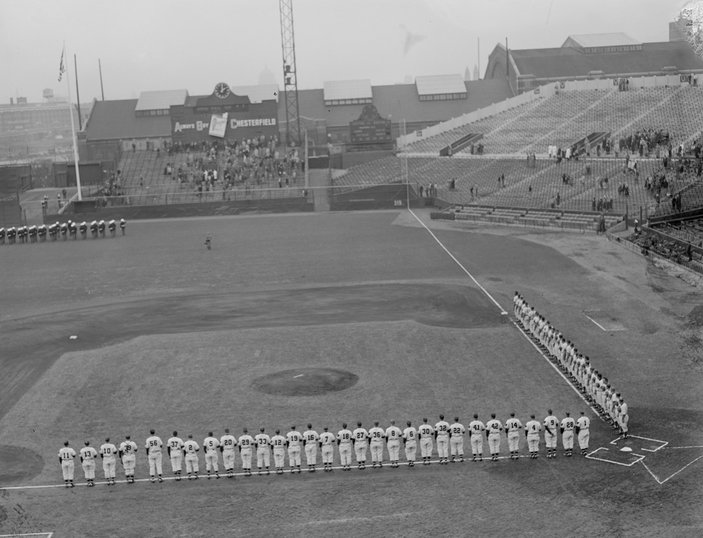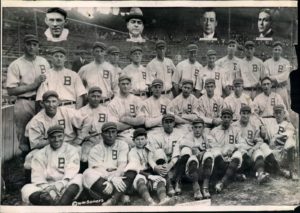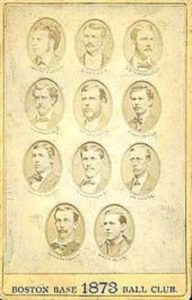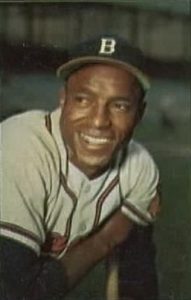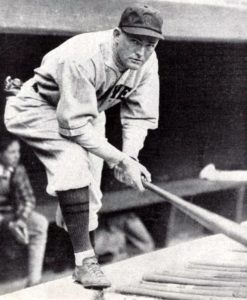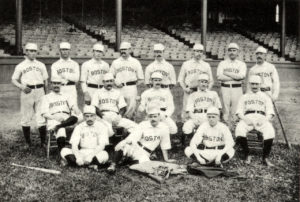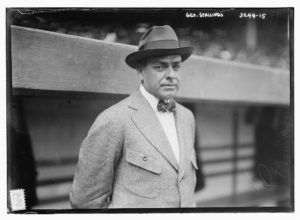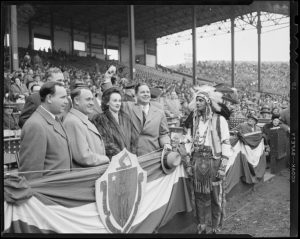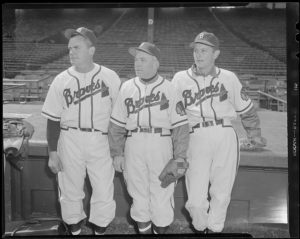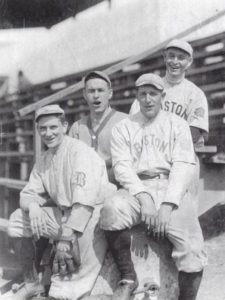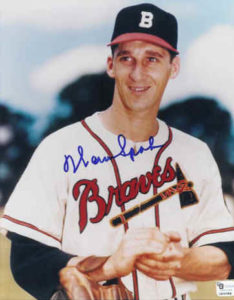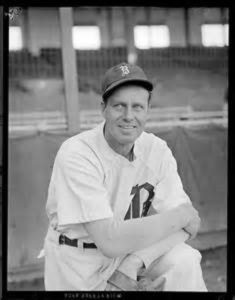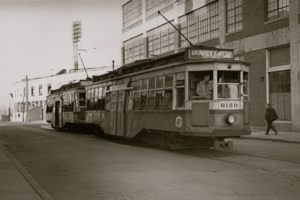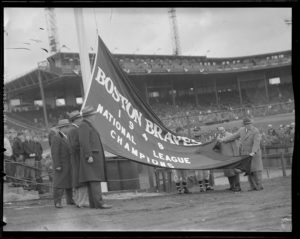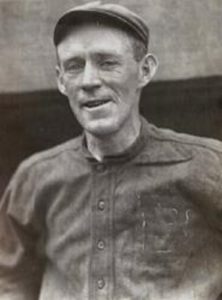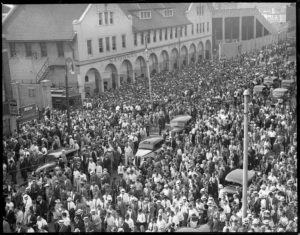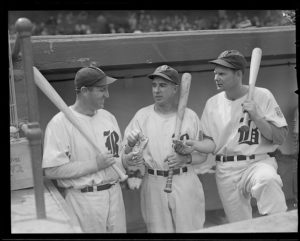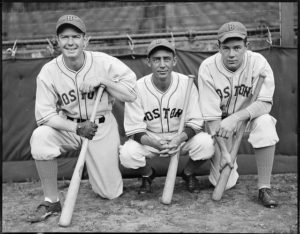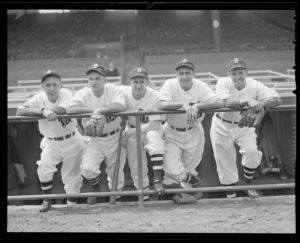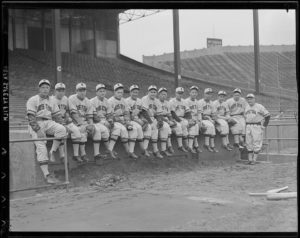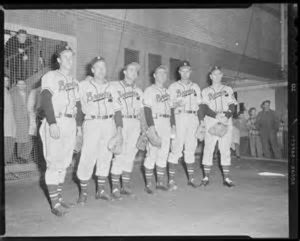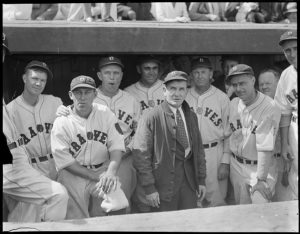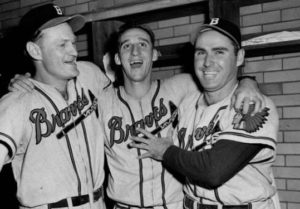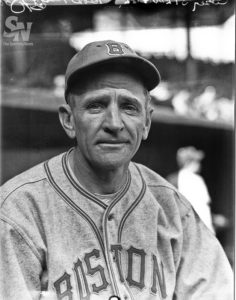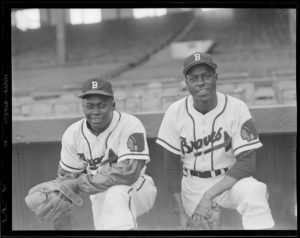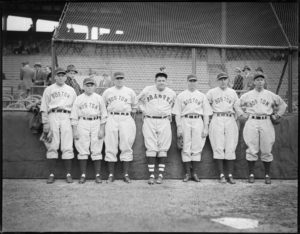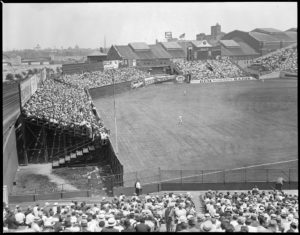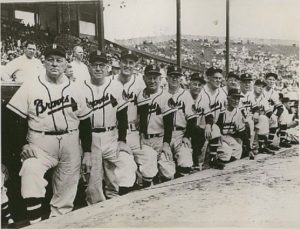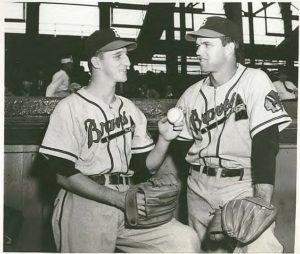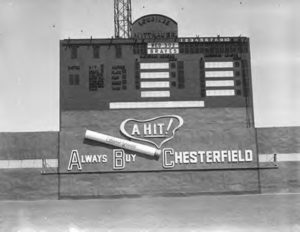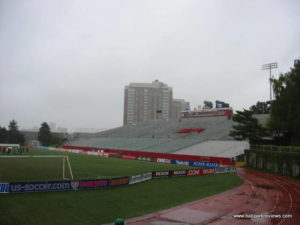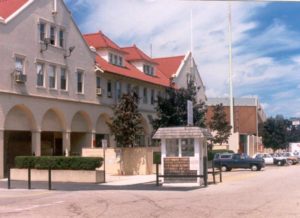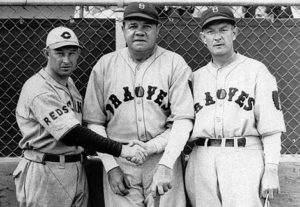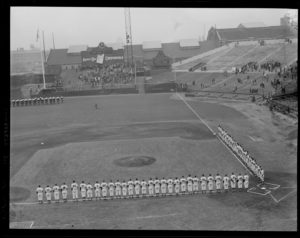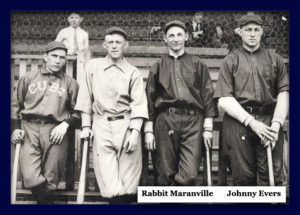Featured Photo Above:
Combined 1903 World Series Photo: Pittsburgh Pirates and Boston Pilgrims
(Color Restoration by Chris Whitehouse of Mancave Pictures)
Baseball History Comes Alive Now Ranked As a Top Five Website by Feedspot Among All Baseball History Websites and Blogs!
(Check out Feedspot's list of the Top 35 Baseball History websites and blogs)

Guest Submissions from Our Readers Always Welcome! Click for details
Subscribe to my blog for automatic updates and as a Bonus get instant access to my two Free Special Reports: “Memorable World Series Moments,” and “Gary’s Handy Dandy World Series Reference Guide!”
Boston Braves Photo Gallery
Click on any image below to start Photo Gallery:
The Demise of a Great Franchise: Boston Braves
I was recently contacted by one of our readers asking for some info on the Boston Braves. As always, I’m glad to oblige requests from our readers!
If there is any doubt as to why the Boston Braves felt compelled to move to Milwaukee in 1953, check out the featured photo below. That from Opening Day, 1952 with near-empty stands. They drew only 281,000 fans for the entire year. Only two games drew more than 10,000. And there was a great baseball town like Milwaukee begging for a major league team and waiting with open arms.
The move to Milwaukee brought a sad end to one of baseball’s great franchises, the Boston Braves. As a matter of fact, they were the longest continuous playing team in American professional sports, having started in 1871 as the Boston Red Stockings, a member of the National Association. (The only other team that has been organized as long, the Chicago Cubs, did not play for the two years following the Great Chicago Fire of 1871.).
Here’s a few words about the Braves’ great history:
In 1876, Boston Red Caps became a charter member of the newly formed National League and were a powerhouse for most of the 19th century. By 1883 they had adopted the name “Beaneaters.” The 1898 team finished 102-47, a club record for wins that stood for nearly a century. They won eight pennants, two under baseball pioneer Harry Wright, and five under Hall-of-Fame manager Frank Selee. The Boston franchise played at South End Grounds form 1871-1914.
With the arrival of the American League in 1901, things changed drastically for the Beaneaters. The team was decimated by competition from the new American League Boston team, as many of their stars jumped to the new team under the lure of higher contracts. They only managed one winning season from 1900 to 1913, and lost 100 games five times.
In 1907, wearing all-white uniforms they were called the “Doves” and the “Rustlers” in 1911. The team adopted an official name, the Braves, for the first time in 1912.This was followed two years later by one of the most memorable seasons in baseball history. After starting the 1914 season a dismal 4-18 start, the Braves seemed to be headed for last place. At one point they were in the cellar at 26-40, 15 games out. From this low point, the “Miracle Braves,” led by stars Johnny Evers and Rabbit Maranville, got hot, closed out at 25-6, and won the National League pennant and the World Series over the heavily-favored Philadelphia Athletics. They are the only team to win a pennant after being in last place on the Fourth of July.
Their new park, Braves Field opened in August 1915. It was the largest park in the majors at the time, with 40,000 seats. The Braves again fell on hard times, with winning records only twice from 1917 to 1932. One bright spot was the arrival of Rogers Hornsby in 1928, hitting .387 to win his seventh and final batting championship. The Braves were competitive in 1933 and 1934 under manager Bill McKechnie, but they were hit hard by the Great Depression. Looking for a way to get more fans and more money, owner Judge Fuchs acquired Babe Ruth, who had his heart set on managing. Ruth was told he could take over as once McKechnie stepped down—perhaps as early as 1936. With his skills severely diminished and seeing a franchise in complete disarray, Ruth retired on June 1–only six days after he clouted three home runs in what was one of the most memorable days in his career. They ultimately finished 38-115, easily the worst season in franchise history. Their .248 winning percentage is the third-worst in baseball history.
After 1935, new ownership changed the name to the “Bees” but under manager Casey Stengel, they fielded some of the worst teams in baseball history. Things looked brighter when Lou Perini took over and they were again the Braves. By 1946, with phenom pitcher, Warren Spahn, the Braves were contenders. In 1948, the team won the pennant, behind the pitching of Spahn and Johnny Sain, who won 39 games between them, and “Spahn and Sain and pray for rain” entered the baseball lexicon. The Braves lost the 1948 World Series in six games to the Indians.
Sam Jethroe was acquired by trade from the Brooklyn Dodgers, on April 18, 1950 and became the franchise’s first African-American player and went on to become the National League Rookie of the Year at age 32. A former Negro League star and military veteran, Jethroe remains the oldest player to have won Rookie of the Year honors. In 1950, Jethroe hit .273 with 100 runs, 18 home runs, 58 RBI, and led the National League with 35 steals
1948 turned out to be the Braves’ last hurrah in Boston. Amid four mediocre seasons, attendance steadily dwindled until, on March 13, 1953, Perini announced he was moving the team to Milwaukee, thus becoming the Milwaukee Braves where they won pennants in 1957 and 1958, with a World Series championship in 1957.
I’ll leave the story here. As we all know they later moved to Atlanta and went on to great success in the 1990s under general manager John Schuerholz and manager Bobby Cox, with a World Series championship in 1995.
Here’s a list of some notable player in Braves history:
- Earl Averill Boston Braves (1941), HOF (1975)
- Dave Bancroft Boston Braves (1924–27), HOF (1971)
- Alvin Dark Boston Braves (1946-49), ROY (1948)
- Johnny Evers Boston Braves (1914–17, 1929), HOF (1946)
- Burleigh Grimes Boston Braves (1930), HOF (1964)
- Billy Herman Boston Braves (1946), HOF (1975)
- Rogers Hornsby Boston Braves (1928), HOF (1942)
- Sam Jethroe Boston Braves (1950–52) ROY (1950)
- Ernie Lombardi Boston Braves (1942), HOF(1986)
- Al Lopez Boston Bees (1936–40), HOF (1977)
- Bill McKechnie Boston Braves (1913, Manager 1930-37), HOF (1962)
- Rabbit Maranville Boston Braves (1912–20, 1929–35), HOF (1954)e
- Eddie Mathews Boston/Milwaukee/Atlanta Braves (1952–66),HOF (1978)
- Christy Mathewson Owner/Executive, Boston Braves (1922–25), HOF as Player (1936)
- Rube Marquard Boston Braves (1922–25), HOF (1971)
- Joe Medwick Boston Braves (1945), HOF (1968)
- Al Simmons Boston Bees (1939), HOF (1953)
- George Sisler Boston Braves (1928–30), HOF (1939)
- Billy Southworth Boston Braves (1921–23, Manager 1946-49, 1950–51), HOF (2008)
- Warren Spahn Boston Braves Boston/Milwaukee Braves (1942, 1946–64), HOF (1973)
- Casey Stengel Boston Braves (1924–25,Manager 1938-43), HOF (1966)
- Babe Ruth Boston Braves (1935), HOF(1936)
- Ed Walsh Boston Braves (1917), HOF (1946)
- Lloyd Waner Boston Braves (1941), HOF (1967)
- Paul Waner Boston Braves (1941–42), HOF (1952)
-Gary Livacari
Photo Credits: All obtained from Google search in public domain and the Leslie Jones Boston Public Library collection
Information: Excerpts edited from the Boston Braves Wikipedia page. Read more at:
Subscribe to my blog for automatic updates and Free Bonus Reports: “Memorable World Series Moments” and “Gary’s Handy Dandy World Series Reference Guide.”
